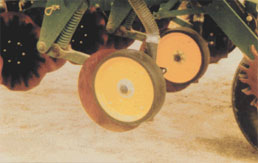
Corn
Planter Scrutiny Needs to Increase
With No-Till
 When
it comes to having a planter tuned up and working well, there is less room
for error in a no-till environment.
When
it comes to having a planter tuned up and working well, there is less room
for error in a no-till environment.
You may have
already expected it. Perhaps it is just logical. But recent research conducted
at the University of Guelph confirms the notion that planter performance can
be much more critical in no-till than in plowed ground. Department of Plant
Agriculture researchers Weidong Liu and Dr. Bill Deen conducted the work.
In their field studies in 2000 and 2001, they used two different planters
to plant in both no-till and conventional tillage situations. The planters
included a relatively new John Deere 1750 (vacuum meter) and an older John
Deere 7000 (finger pick-up); both planters were similarly equipped. They also
ran both planters at two planting speeds, 4.5 mph and 7.0 mph.
| Table
1: The impact of planter, tillage and planting speed on corn yield. Average from Elora and Woodstock, 2000 and 2001. |
||||
|
(mph)
Corn Planter |
Tillage
System
|
Planting
Speed
|
||
|
Conventional
|
No-till
|
4.5
|
7.0
|
|
|
----------------
Corn Yield (bu/ac) ----------------
|
||||
|
John
Deere 7000
Finger Pick-up (1986 Model) |
129
|
113
|
126
|
116
|
|
John
Deere 1750
Vacuum Meter (1998 Model) |
126
|
121
|
125
|
122
|
|
W.
Liu and B. Deen, University of Guelph
|
||||
The results,
highlighted in Table 1, indicate that the poorer planter performance, which
you might have associated with the older planter, resulted in lower yields
only within the no-till system. The research also carried out extensive measurements
within the plots to determine what feature of the plant stand has the most
impact on yield. Is it population? Is it uniformity of spacing within the
stand? Is it uniformity of emergence? The real answer, of course, is probably
that all three aspects combined create the total observed impact on yield.
However, it is interesting to note that uniformity of spacing changed very
little for either planter as it moved from conventional to no-till. The more
apparent causes of yield loss with the 7000 planter compared to the 1750 under
the no-till conditions were reduced population and poorer emergence timing.
The seed may well have been dropped accurately enough (in terms of spacing),
but if the depth control and seed-to-soil contact is insufficient in the no-till
conditions, the yield penalty appears.
| Table 2: The effect of planting speed on spacing standard deviation, population and corn yield. Average of 11 Illinois trials, 1994-1996. | |||
|
Planting
Speed |
Standard
Deviation
(inches) |
Population
(plants/acre) |
Yield
(bu/ac) |
|
3
|
2.87
|
27,231
|
152.5
|
|
5
|
2.99
|
27,373
|
152.2
|
|
7
|
3.22
|
26,996
|
153.1
|
|
E.
Nafziger, Univ. of Illinois and H. Brown Pioneer Hi-Bred
|
|||
In general, the research highlights the importance of maintaining the ground-engaging parts of the planter. There may be a bit of room for tolerance in worked ground, but in no-till the openers, seed firmers and closing wheels will need to be in good shape. The other point you might take from this work is not to spend money ensuring that spacing and population are exact if you have not first ensured that the planter will place the seed in the ground in such a way as to provide for very uniform emergence. The first and best dollar spent on your corn planter is to ensure uniform emergence. Your planter simply must be able to cut a clean V into moisture, lay the seed in the bottom of that trench and cover and firm the soil around it. A new double disc and bearing at approximately $35 dollars is well worth it if your current disc assemblies are worn out. Also be sure the pinch point on the double disc openers is tight. If you run a business card between the opener discs, you should not be able to pull it out as it passes through the 4 o’clock to 6 o’clock positions on the openers. Adjustment of the shims may improve this if the discs themselves are still in reasonable shape. And to repeat the theme, it appears that all of this becomes increasingly important as you reduce tillage.
Speed
Kills?
The other aspect of the work showed less difference in yield resulting from
planting speed – but this seemed somewhat dependent on the type of the
planter. Subjecting the older, finger pick-up planter to high speeds may be
a real detriment to planter performance and yield. And of course, this will
be compounded in tougher no-till conditions or rougher seedbeds. The relatively
new, vacuum planter seemed to handle the higher speeds without much problem.
This agrees with data from Illinois (shown in Table 2) which indicates that
with a modern, well maintained corn planter used under suitable field conditions,
yield losses due to variability caused by faster planting speeds will be negligible
and may be offset by getting more corn planted on time.